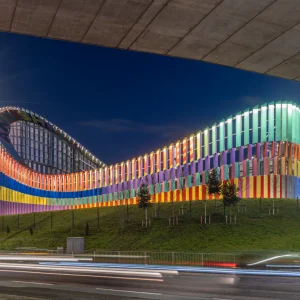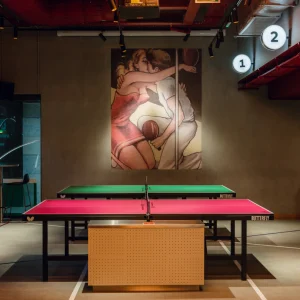Vopnaburia or armory is located among the retrofitted, once-rusting ships and abandoned private fisheries of Reykjavik’s Fishpacking District, on an isolated area, to control client visits and allow for a one-on-one interaction with attendants.
Everything used in putting Vopnaburia together was reclaimed from the now abandoned construction sites around Reykjavík – from the dried and weather worn-shipping palettes to the long wood scaffolding, old metal frames, steps and wheeled bases. The store’s sign was made from discarded rusted roofing sheets and cut to shape with a water jet. To create the color of the floor, the designer mixed a hue somewhere between blood and rust – an overall theme and tone for the store.
While designing the store, as the former layers of the room was stripped away, its structure and colossal concrete beams emerged, which became the grand highlights that now define the space. The high walls are lined with a patterned corrugated cardboard, and the industrial castors are bestowed by the custodial facility from their inoperative waste containers. The floating ceiling hides old crucifix-shaped timber girders that supported the structure, from which lights are hung.
The store offers a collection of Sruli Recht non-products – a gradually growing arsenal of accidents caught somewhere between product design, weapons manufacturing, corroded tailoring, and shoe making. Vopnaburia presents one new ‘non-product’ every month, right from umbrellas and bulletproof scarves, to tables, bags, belts and boots, and incorporates such materials as concrete, diamonds, skin, and wool.
The series of illustrated topo-graphic narratives from Megan Herbert are motivated by old Czechoslovakian telegrams, transmitting distressing and beautiful messages. Each timber shield is formed from layers of historical paper, intricate paper cuts and illustrations to tell a story.





